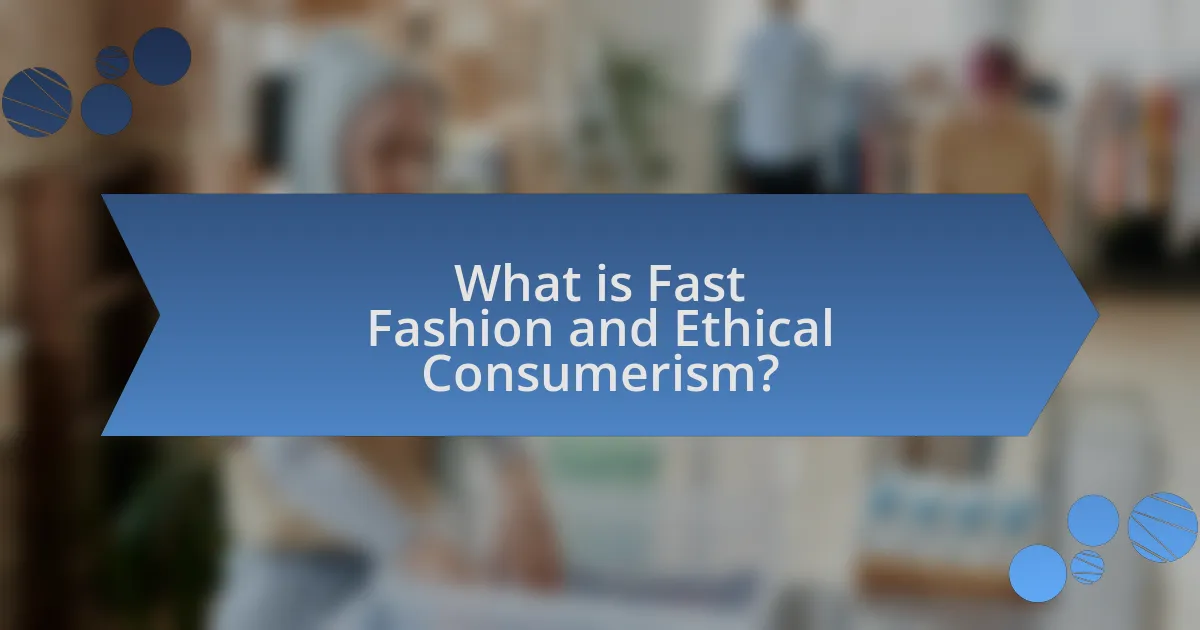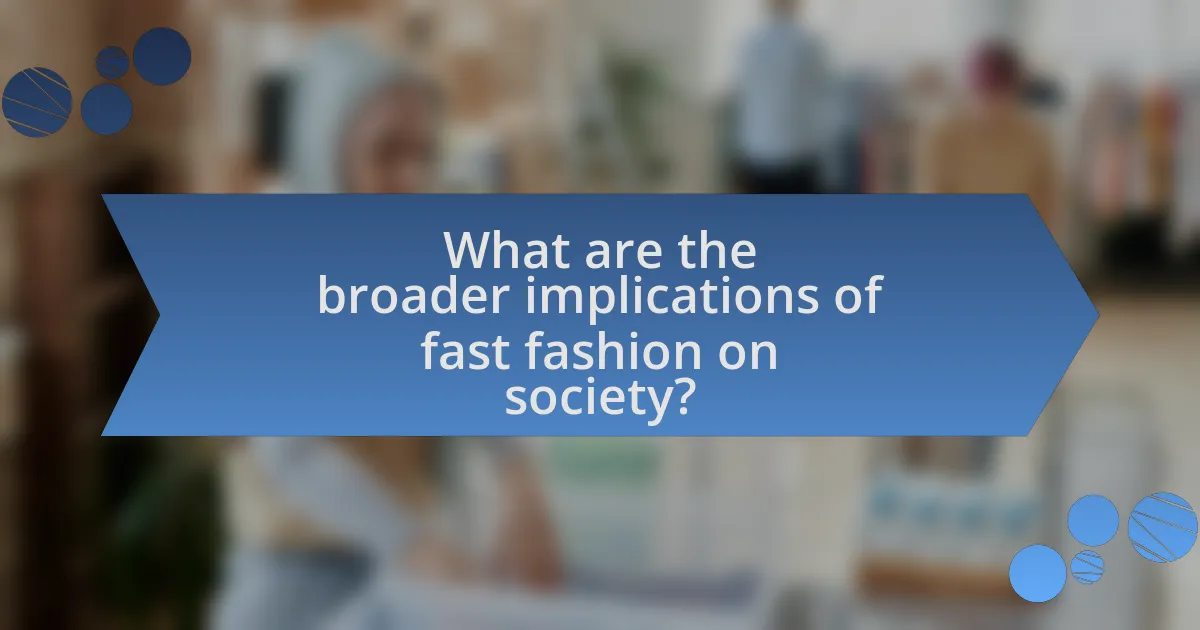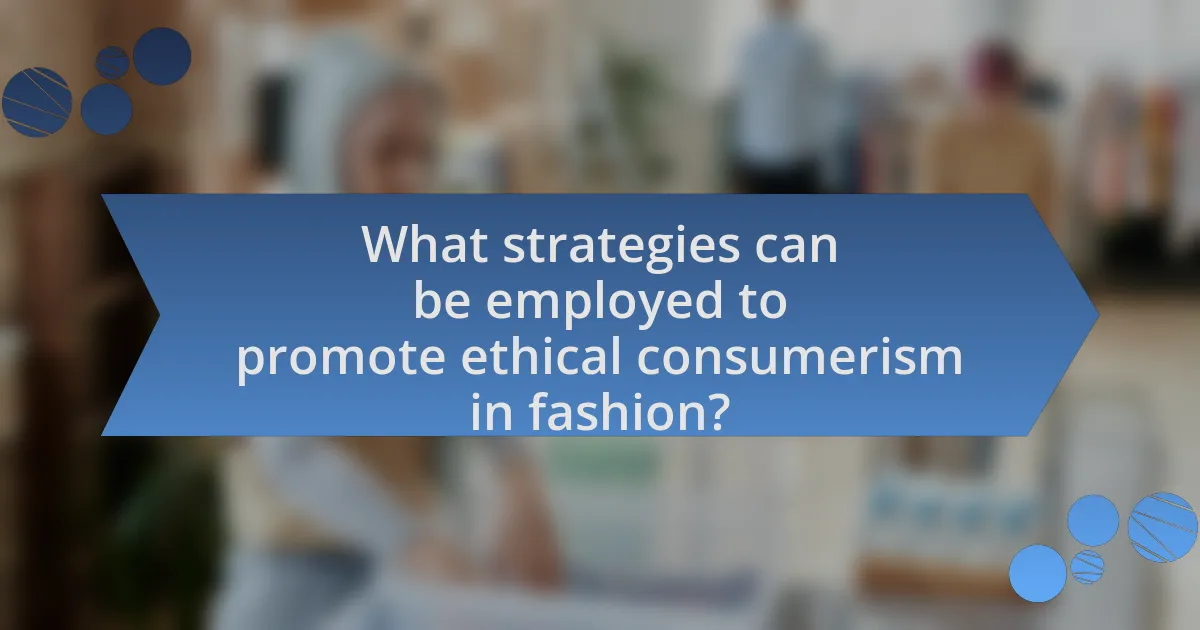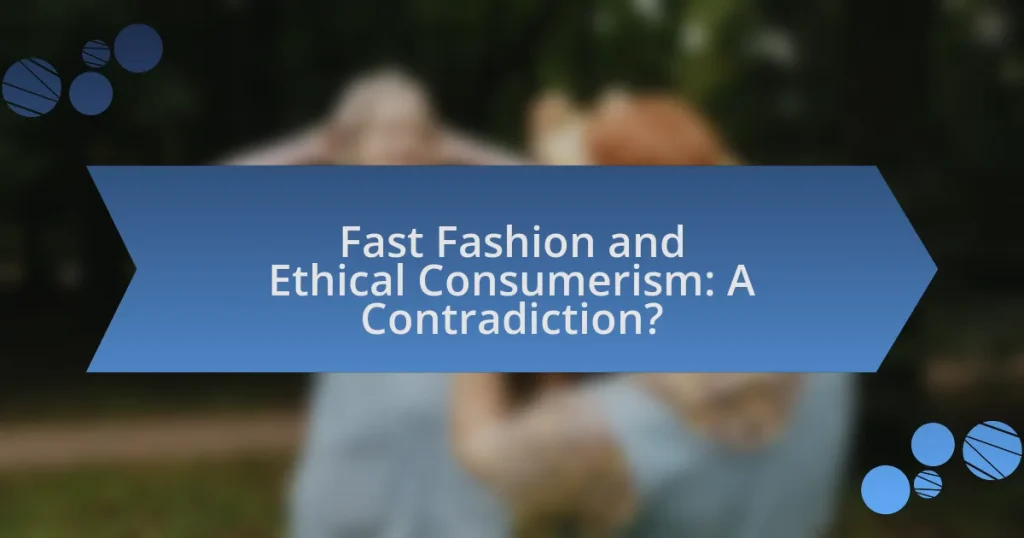Fast fashion is characterized by the rapid production of inexpensive clothing to meet current trends, often resulting in negative environmental and social consequences, such as poor labor conditions and high waste generation. Ethical consumerism, in contrast, emphasizes purchasing decisions that consider the ethical implications of products, including sustainability and fair labor practices. This article explores the intersection of fast fashion and ethical consumerism, highlighting the contradictions between the two, the environmental and social issues associated with fast fashion, and the growing consumer demand for sustainable alternatives. It also discusses consumer behaviors, motivations for choosing ethical brands, and practical steps for navigating the fashion landscape responsibly.

What is Fast Fashion and Ethical Consumerism?
Fast fashion refers to the rapid production of inexpensive clothing to meet the latest trends, often resulting in significant environmental and social impacts. This model prioritizes speed and low cost, leading to practices such as poor labor conditions and high waste generation. Ethical consumerism, on the other hand, involves purchasing decisions that consider the ethical implications of products, including their environmental impact and the treatment of workers. Consumers engaged in ethical consumerism often seek to support brands that prioritize sustainability and fair labor practices, creating a tension with the fast fashion model, which typically undermines these values.
How do fast fashion and ethical consumerism intersect?
Fast fashion and ethical consumerism intersect through the tension between rapid production of inexpensive clothing and the growing demand for sustainable and ethically produced goods. Fast fashion brands prioritize low costs and quick turnaround times, often at the expense of labor rights and environmental sustainability. In contrast, ethical consumerism advocates for responsible purchasing decisions that consider the social and environmental impacts of products. This intersection highlights a conflict where consumers increasingly seek to support brands that align with their values, leading to a rise in sustainable fashion alternatives. According to a 2021 report by McKinsey & Company, 67% of consumers consider sustainability when making a purchase, indicating a significant shift towards ethical consumerism despite the prevalence of fast fashion.
What are the defining characteristics of fast fashion?
Fast fashion is characterized by its rapid production of inexpensive clothing that mimics current fashion trends. This model relies on quick turnaround times, often producing new collections every few weeks to keep up with consumer demand. Additionally, fast fashion brands typically prioritize low costs, which can lead to poor labor practices and environmental degradation. For instance, the industry is known for its significant contribution to pollution and waste, with the Ellen MacArthur Foundation reporting that the fashion industry is responsible for 10% of global carbon emissions.
What principles underpin ethical consumerism?
The principles that underpin ethical consumerism include sustainability, social justice, and transparency. Sustainability emphasizes the need for products to be environmentally friendly and produced in a way that does not deplete natural resources. Social justice focuses on fair labor practices, ensuring that workers are treated ethically and compensated fairly. Transparency requires companies to disclose their supply chain practices, allowing consumers to make informed choices about the products they purchase. These principles are supported by research indicating that consumers increasingly prefer brands that align with their ethical values, with a 2021 survey showing that 66% of global consumers are willing to pay more for sustainable brands.
Why is the relationship between fast fashion and ethical consumerism considered a contradiction?
The relationship between fast fashion and ethical consumerism is considered a contradiction because fast fashion prioritizes rapid production and low costs, often at the expense of ethical labor practices and environmental sustainability. Fast fashion brands typically exploit cheap labor in developing countries, leading to poor working conditions and low wages, which directly opposes the principles of ethical consumerism that advocate for fair treatment of workers and sustainable practices. For instance, a report by the Ethical Consumer Research Association highlights that the fast fashion industry is responsible for significant environmental degradation and labor exploitation, undermining the ethical values that consumers seek to support.
How does fast fashion impact the environment?
Fast fashion significantly impacts the environment by contributing to pollution, waste, and resource depletion. The production of fast fashion items often involves toxic chemicals, which can contaminate water sources and harm ecosystems. For instance, the fashion industry is responsible for 20% of global wastewater, primarily due to dyeing processes. Additionally, fast fashion leads to massive textile waste; approximately 92 million tons of textiles are discarded each year, with much ending up in landfills. Furthermore, the rapid production cycles require vast amounts of water, with the industry consuming around 79 billion cubic meters annually, exacerbating water scarcity issues. These factors collectively illustrate the detrimental environmental consequences of fast fashion.
What social issues are associated with fast fashion production?
Fast fashion production is associated with several significant social issues, including labor exploitation, unsafe working conditions, and the perpetuation of poverty in garment-producing countries. Workers in the fast fashion industry often face long hours, low wages, and lack of labor rights, with reports indicating that many earn less than the living wage. For instance, a 2019 report by the Clean Clothes Campaign highlighted that garment workers in countries like Bangladesh and Cambodia frequently work in hazardous environments without proper safety measures, leading to accidents and health risks. Additionally, the fast fashion model encourages a cycle of overconsumption, which can undermine local economies and contribute to social inequality.
What are the consumer behaviors related to fast fashion and ethical choices?
Consumer behaviors related to fast fashion and ethical choices often reflect a tension between affordability and sustainability. Many consumers are drawn to fast fashion due to its low prices and trendy offerings, leading to high purchase frequency and a disposable mindset. However, a growing segment of consumers is increasingly prioritizing ethical considerations, such as environmental impact and labor practices, influencing their purchasing decisions. For instance, a 2021 survey by McKinsey & Company found that 67% of consumers consider sustainability when making fashion purchases, indicating a shift towards more ethical consumerism. This duality in behavior highlights the complexity of consumer motivations, where convenience and cost compete with a desire for responsible consumption.
How do consumers justify purchasing fast fashion items?
Consumers justify purchasing fast fashion items primarily by emphasizing affordability and trend accessibility. Many individuals perceive fast fashion as a way to stay fashionable without significant financial investment, as brands often offer low prices for the latest styles. This perception is supported by the fact that the fast fashion industry has grown to a market size of over $35 billion in the U.S. alone, indicating a strong consumer demand for inexpensive clothing options. Additionally, consumers often rationalize their purchases by believing that they are not contributing significantly to environmental harm due to the perceived disposability of these items, despite evidence showing that fast fashion contributes to substantial waste and pollution.
What motivates consumers to choose ethical brands over fast fashion?
Consumers are motivated to choose ethical brands over fast fashion primarily due to concerns about sustainability and social responsibility. Research indicates that 66% of global consumers are willing to pay more for sustainable brands, reflecting a growing awareness of the environmental impact of fast fashion, which contributes to significant waste and pollution. Additionally, ethical brands often promote fair labor practices, appealing to consumers’ desire for social justice and humane working conditions. A study by Nielsen found that 73% of millennials are willing to spend more on a product if it comes from a sustainable brand, highlighting the shift in consumer values towards ethical consumption.
How can consumers navigate the fast fashion landscape ethically?
Consumers can navigate the fast fashion landscape ethically by prioritizing sustainable brands that emphasize ethical production practices. Research indicates that brands like Patagonia and Everlane are committed to transparency in their supply chains and use environmentally friendly materials. Additionally, consumers can reduce their overall consumption by opting for second-hand clothing, which has been shown to significantly decrease waste; a study by the Ellen MacArthur Foundation found that extending the life of garments by just nine months can reduce carbon, water, and waste footprints by 20-30%. Engaging in clothing swaps and supporting local artisans also fosters a more sustainable fashion ecosystem.
What alternatives exist to fast fashion for ethical consumers?
Ethical consumers can choose sustainable fashion brands, thrift shopping, and clothing rental services as alternatives to fast fashion. Sustainable fashion brands, such as Patagonia and Everlane, prioritize eco-friendly materials and fair labor practices, reducing environmental impact and promoting ethical production. Thrift shopping allows consumers to purchase second-hand clothing, extending the lifecycle of garments and minimizing waste. Clothing rental services, like Rent the Runway, offer access to high-quality apparel without the commitment of ownership, promoting a circular economy. These alternatives collectively address the ethical concerns associated with fast fashion by emphasizing sustainability and responsible consumption.
What are the benefits of choosing sustainable fashion brands?
Choosing sustainable fashion brands offers numerous benefits, primarily reducing environmental impact and promoting ethical labor practices. Sustainable fashion brands typically use eco-friendly materials and processes, which significantly lower carbon emissions and waste compared to conventional fast fashion. For instance, the Ellen MacArthur Foundation reports that the fashion industry is responsible for 10% of global carbon emissions, highlighting the urgent need for sustainable alternatives. Additionally, these brands often ensure fair wages and safe working conditions for their workers, addressing labor exploitation prevalent in fast fashion. According to the Fashion Revolution’s 2021 report, 77% of consumers want brands to be transparent about their supply chains, indicating a growing demand for ethical practices. Thus, choosing sustainable fashion not only benefits the planet but also supports social equity.
How can consumers identify truly ethical brands?
Consumers can identify truly ethical brands by researching their supply chain transparency, labor practices, and environmental impact. Ethical brands often provide detailed information about their sourcing, production processes, and the treatment of workers, which can be verified through third-party certifications such as Fair Trade, B Corp, or Global Organic Textile Standard. For instance, a 2021 report by the Ethical Consumer Research Association found that brands with transparent supply chains and ethical certifications are more likely to adhere to fair labor practices and sustainable sourcing. Additionally, consumers can look for brands that actively engage in social responsibility initiatives and demonstrate a commitment to reducing their carbon footprint.

What are the broader implications of fast fashion on society?
Fast fashion has significant broader implications on society, primarily contributing to environmental degradation, social inequality, and consumer culture. The rapid production cycles and low-cost garments lead to increased waste, with an estimated 92 million tons of textile waste generated annually, according to the United Nations. Additionally, fast fashion often relies on exploitative labor practices in developing countries, where workers face poor conditions and low wages, exacerbating social inequality. This industry also promotes a culture of disposability, encouraging consumers to prioritize quantity over quality, which undermines sustainable practices and ethical consumerism.
How does fast fashion influence global labor practices?
Fast fashion significantly influences global labor practices by promoting low-cost production methods that often exploit workers. This industry prioritizes rapid production and low prices, leading to poor working conditions, long hours, and inadequate wages for laborers, particularly in developing countries. For instance, a report by the International Labour Organization indicates that garment workers in countries like Bangladesh earn as little as $95 per month, far below the living wage. Additionally, fast fashion’s demand for quick turnaround times encourages manufacturers to cut corners on labor rights, resulting in violations such as child labor and unsafe working environments. Thus, the fast fashion model perpetuates a cycle of exploitation and undermines ethical labor standards globally.
What are the working conditions in fast fashion factories?
Working conditions in fast fashion factories are often characterized by low wages, long hours, and unsafe environments. Workers frequently endure excessive overtime, sometimes exceeding 60 hours per week, with minimal breaks. Reports indicate that many factories lack proper safety measures, leading to hazardous conditions, such as exposure to toxic chemicals and inadequate ventilation. For instance, the 2013 Rana Plaza collapse in Bangladesh, which killed over 1,100 workers, highlighted the dire safety issues prevalent in the industry. Additionally, labor rights organizations have documented instances of verbal and physical abuse, as well as the suppression of workers’ rights to unionize. These conditions reflect a systemic disregard for worker welfare in the pursuit of fast fashion profits.
How do labor rights movements respond to fast fashion practices?
Labor rights movements respond to fast fashion practices by advocating for improved working conditions, fair wages, and the enforcement of labor laws in garment factories. These movements highlight the exploitation of workers in the fast fashion industry, where low wages and unsafe working environments are prevalent. For instance, the 2013 Rana Plaza collapse in Bangladesh, which killed over 1,100 workers, underscored the urgent need for reform and led to increased activism. Organizations like the Clean Clothes Campaign and the International Labor Rights Forum mobilize public awareness and pressure brands to adopt ethical sourcing practices, ensuring that workers’ rights are respected and upheld.
What role does consumer awareness play in the fast fashion debate?
Consumer awareness plays a crucial role in the fast fashion debate by influencing purchasing decisions and promoting ethical consumption. When consumers are informed about the environmental and social impacts of fast fashion, such as the exploitation of labor and the depletion of natural resources, they are more likely to seek sustainable alternatives. Research indicates that 66% of global consumers are willing to pay more for sustainable brands, highlighting the power of informed choices in driving industry change. Increased consumer awareness can lead to greater demand for transparency and accountability from brands, ultimately pushing the fashion industry towards more ethical practices.
How can education impact consumer choices regarding fast fashion?
Education can significantly influence consumer choices regarding fast fashion by increasing awareness of its environmental and ethical implications. When consumers are educated about the negative impacts of fast fashion, such as pollution, waste, and labor exploitation, they are more likely to make informed decisions that favor sustainable alternatives. Research conducted by the Journal of Consumer Research indicates that consumers who receive education on sustainability are more inclined to support ethical brands and reduce their consumption of fast fashion items. This shift in behavior is driven by a desire to align personal values with purchasing decisions, ultimately leading to a decrease in demand for fast fashion products.
What resources are available for consumers to learn about ethical fashion?
Consumers can learn about ethical fashion through various resources, including websites, books, documentaries, and social media platforms. Websites like Good On You provide ratings and information on brands’ ethical practices, while books such as “Fashionopolis” by Dana Thomas explore the impact of fashion on the environment and society. Documentaries like “The True Cost” highlight the consequences of fast fashion, and social media platforms often feature influencers and organizations advocating for sustainable practices. These resources collectively offer insights into ethical fashion, helping consumers make informed choices.

What strategies can be employed to promote ethical consumerism in fashion?
To promote ethical consumerism in fashion, brands can implement transparency in their supply chains. Transparency allows consumers to understand the origins of products, including labor practices and environmental impact. For instance, a 2021 survey by Fashion Revolution found that 79% of consumers want to know where their clothes come from, indicating a strong demand for ethical practices. Additionally, brands can adopt sustainable materials and production methods, which not only reduce environmental harm but also appeal to eco-conscious consumers. Research from McKinsey & Company highlights that 67% of consumers consider sustainability when making a purchase, reinforcing the importance of ethical strategies in attracting a responsible customer base.
How can brands encourage ethical consumerism?
Brands can encourage ethical consumerism by adopting transparent supply chains and promoting sustainable practices. By providing clear information about sourcing, production methods, and labor conditions, brands can build trust with consumers who prioritize ethical considerations. For instance, a study by the Ethical Consumer Research Association found that 66% of consumers are willing to pay more for products from companies that demonstrate ethical practices. Additionally, brands can implement initiatives such as fair trade certifications and eco-friendly materials, which not only enhance their credibility but also align with the growing demand for responsible consumption.
What marketing strategies resonate with ethically-minded consumers?
Ethically-minded consumers respond positively to marketing strategies that emphasize transparency, sustainability, and social responsibility. These consumers prefer brands that openly share their sourcing practices, production processes, and the impact of their operations on the environment and society. For instance, a study by Nielsen found that 66% of global consumers are willing to pay more for sustainable brands, indicating a strong preference for companies that align with their ethical values. Additionally, storytelling that highlights a brand’s commitment to ethical practices, such as fair labor conditions and eco-friendly materials, further engages this demographic. Brands like Patagonia exemplify this approach by promoting their environmental initiatives and ethical supply chain, which resonates deeply with ethically-minded consumers.
How can transparency in supply chains enhance brand trust?
Transparency in supply chains enhances brand trust by allowing consumers to verify the ethical practices and sourcing of products. When brands openly share information about their supply chain processes, including labor conditions, sourcing materials, and environmental impact, they build credibility with consumers who prioritize ethical considerations. Research indicates that 66% of consumers are willing to pay more for sustainable brands, demonstrating that transparency can lead to increased customer loyalty and trust. Brands that provide clear, accessible information about their supply chains are more likely to foster a positive relationship with consumers, as they align with the growing demand for accountability in the fast fashion industry.
What practical steps can consumers take to support ethical fashion?
Consumers can support ethical fashion by choosing to buy from brands that prioritize sustainable practices and fair labor conditions. This includes researching companies to ensure they use eco-friendly materials, pay fair wages, and maintain transparent supply chains. For instance, brands like Patagonia and Everlane are known for their commitment to ethical practices. Additionally, consumers can reduce their overall consumption by opting for second-hand clothing, which minimizes waste and extends the lifecycle of garments. According to a report by the Ellen MacArthur Foundation, extending the life of clothing by just nine months can reduce carbon, water, and waste footprints by around 20-30%. By making informed purchasing decisions and advocating for ethical practices, consumers can significantly impact the fashion industry.
How can consumers reduce their fashion footprint effectively?
Consumers can effectively reduce their fashion footprint by opting for sustainable clothing choices, such as purchasing from eco-friendly brands, buying second-hand items, and prioritizing quality over quantity. Research indicates that the fashion industry is responsible for 10% of global carbon emissions, highlighting the importance of conscious consumerism. By choosing sustainable materials and supporting brands that practice ethical production, consumers can significantly lower their environmental impact. Additionally, extending the lifespan of clothing through proper care and repair can further minimize waste, as the average consumer discards 81 pounds of clothing annually, contributing to landfill overflow.
What are the best practices for sustainable shopping?
The best practices for sustainable shopping include prioritizing eco-friendly products, supporting local businesses, and reducing consumption. Eco-friendly products are made from sustainable materials and have a lower environmental impact; for example, organic cotton uses 91% less water than conventional cotton. Supporting local businesses reduces carbon emissions associated with transportation and fosters community economies. Additionally, reducing consumption by buying only what is necessary helps minimize waste and resource depletion, as the fashion industry is responsible for 10% of global carbon emissions. Implementing these practices contributes to a more sustainable shopping experience.
What future trends might shape the relationship between fast fashion and ethical consumerism?
Future trends that might shape the relationship between fast fashion and ethical consumerism include increased consumer awareness, technological advancements in sustainable materials, and regulatory changes promoting ethical practices. As consumers become more informed about the environmental and social impacts of fast fashion, they are likely to demand greater transparency and accountability from brands. A report by McKinsey & Company indicates that 67% of consumers consider sustainability when making purchasing decisions, highlighting a shift towards ethical consumerism. Additionally, innovations in sustainable textiles, such as biodegradable fabrics and recycling technologies, are expected to influence fast fashion brands to adopt more eco-friendly practices. Lastly, governments are increasingly implementing regulations aimed at reducing waste and promoting ethical labor practices, which could compel fast fashion companies to align with ethical consumer expectations.
How might technology influence sustainable fashion practices?
Technology significantly influences sustainable fashion practices by enabling more efficient production processes and reducing waste. Innovations such as 3D printing allow for on-demand manufacturing, which minimizes excess inventory and lowers resource consumption. Additionally, advancements in materials science have led to the development of biodegradable fabrics and recycled materials, further decreasing the environmental impact of clothing production. For instance, a study published in the Journal of Cleaner Production found that using recycled polyester can reduce energy consumption by up to 60% compared to virgin polyester. Furthermore, digital platforms facilitate transparency in supply chains, allowing consumers to make informed choices about the sustainability of their purchases. These technological advancements collectively contribute to a more sustainable fashion industry.
What role do social movements play in shaping consumer behavior?
Social movements significantly influence consumer behavior by raising awareness about ethical issues and promoting sustainable practices. For instance, movements advocating for environmental sustainability have led consumers to prefer brands that demonstrate eco-friendly practices, resulting in a shift towards sustainable fashion choices. Research indicates that 66% of global consumers are willing to pay more for sustainable brands, highlighting the impact of social movements on purchasing decisions. Additionally, campaigns like “Fashion Revolution” have encouraged transparency in the fashion industry, prompting consumers to demand accountability from brands regarding labor practices and environmental impact. This shift in consumer behavior reflects the power of social movements in shaping market trends and influencing corporate practices.















